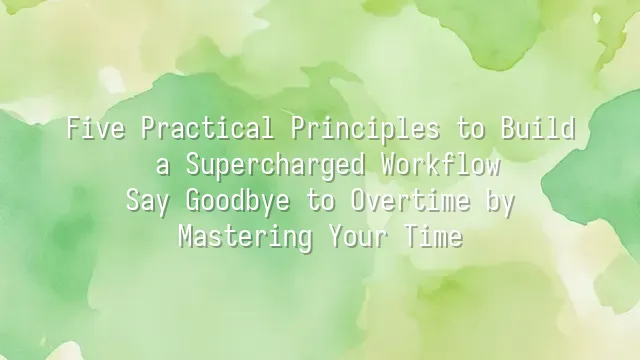
The Art of Mastering Time Instead of Being Chased by It
The key to boosting office productivity isn't about cramming more tasks in, but making precise choices about what to do. Most people fall into the trap of "reactive work"—opening their computers each morning only to be chased by emails and messages. They appear busy, yet their actual output is diluted. Real breakthroughs come from establishing a "proactive rhythm": using time blocking to reserve dedicated slots for deep work, and applying the Eisenhower Matrix to distinguish between what's important and what's urgent. When your calendar clearly states "9–11 a.m.: Focus on Project Proposal," any last-minute meeting request must wait its turn. You’ll find that 80% of requests marked “ASAP” are merely noise. Recognizing pseudo-urgent tasks is the first step toward cutting off sources of distraction.
Even more important is respecting your personal biological rhythm. Some people think most clearly in the morning, yet are forced into pointless early meetings; others enter flow state only in the evening, only to have their focus shattered by scattered appointments. Rather than blindly conforming to group schedules, honestly assess your peak performance periods and schedule critical tasks during these optimal windows. Time management isn’t about filling every minute—it’s about maximizing cognitive return per minute. This mindset is where true productivity begins.
Building Your Digital Arsenal for an Efficient Workflow Fortress
The next stage of improving office efficiency lies in constructing a solid digital infrastructure. Tools aren't effective because there are many, but because they are specialized and well-integrated. Too many people suffer from "tool-hopping syndrome": using Trello today, switching to Asana tomorrow, wasting all their time on learning curves and data synchronization. A truly efficient digital ecosystem follows the "one task, one tool" principle—Todoist for personal to-dos, Notion for knowledge bases and project tracking, Google Drive for unified document access—each with a clear role, none overlapping.
A more advanced strategy involves introducing automation engines like n8n or Zapier to offload repetitive tasks to machines. For example, set up rules so that incoming client emails are automatically categorized, calendar events created, and new task cards added to your Notion board. In this way, your inbox stops being a stress source and becomes a data gateway driving your workflow. The key is letting processes dictate tools—not allowing tool logic to dictate your behavior. When emails, meetings, and collaboration seamlessly connect, communication noise reduction gains a technical foundation.
Communication Noise Reduction: Reclaim Your Inbox
The biggest hidden tax on office productivity is often the fragmentation caused by communication itself. Instant messages and email notifications act like unpredictable bombs, repeatedly shattering your focus. The solution is to establish a "batch communication" system—checking and replying to emails only during fixed times each day, combined with pre-written templates for common requests. These two simple tactics alone can save over three hours weekly. Going further, use the "snooze" function instead of messy labels, allowing pending items to resurface automatically at the right moment.
At the team level, build consensus around initiatives such as declaring weekly "no-email days," or shifting discussions to themed channels on platforms like Slack to reduce the barrage of private messages. Also adopt the "three-second rule": pause for three seconds after receiving a message and ask yourself, "Will someone die if I don’t reply immediately?" Most of the time, the answer is no. That brief pause prevents falling into reactive busyness. When communication shifts from an instant battlefield to a manageable process, real productive space is finally freed up.
The Alchemy of Focus: Breaking Free from the Multitasking Myth
The psychological truth behind office productivity is this: multitasking isn't a skill—it's a cognitive scam. Neuroscience research shows that every time you switch tasks, your brain needs 0.5 to 1 second to reload context. Accumulated over a day, this can consume over 20% of your effective working time. The reason the Pomodoro Technique endures is precisely because it aligns with this insight—25 minutes of intense focus, during which you avoid email and messages entirely, allowing the prefrontal cortex to operate continuously. The following 5-minute break should involve walking or closing your eyes, not scrolling through your phone, to prevent cognitive overload.
To amplify this effect, create a "deep work ritual": wear specific headphones, play low-frequency white noise, set up a dedicated desktop layout—let environmental cues train your brain to know that "entering this space means entering battle mode." Combine this with website blockers to disable social media and turn off non-essential notifications, eliminating distractions at the system level. These aren't just time tricks—they’re precise allocations of cognitive resources, preserving mental bandwidth for deeper environmental optimization.
Reshaping Your Environment to Unlock Hidden Productivity
The ultimate frontier of office efficiency isn't willpower—it's environment design. Physically, an ergonomic chair isn't a luxury, but a basic defense against afternoon slouching and mental fatigue. Lighting also matters greatly—cool white light enhances concentration, while warm yellow light stabilizes mood. Using both strategically helps maintain performance throughout the day. Desk tidiness should resemble Hong Kong-style milk tea—just the right tea-to-milk ratio. Too empty, and inspiration fades; too cluttered, and decision-making energy drains.
The digital environment is an even greater productivity black hole. Naming files like "New Folder (12)" plants a time bomb for future chaos. Instead, adopt standardized naming like "Project_Date_Version," paired with a folder structure of no more than three levels. Use system search syntax such as "modified:yesterday type:pdf" to locate files instantly. The core principle is the "path of least effort"—frequently used files and tools must be accessible within three seconds. Spend just 10 minutes a week organizing your digital space, and over six months, you’ll effectively reclaim three full days otherwise lost searching for things—that’s tangible, measurable productivity gain.

 English
English
 اللغة العربية
اللغة العربية  Bahasa Indonesia
Bahasa Indonesia  Bahasa Melayu
Bahasa Melayu  ภาษาไทย
ภาษาไทย  Tiếng Việt
Tiếng Việt  简体中文
简体中文 